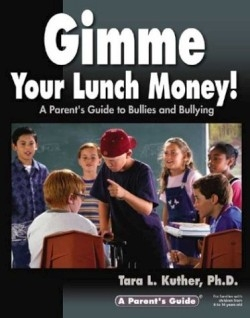
Gimme Your Lunch Money!
The Complete Guide to Bullies and Bullying
Contrary to the adult view of bullies, in which one lone playground bully torments one victim, the author reports that three out of four elementary school children say they are either victims of bullies or bullies themselves. With such a large portion of children subject to witnessing, participating in, or experiencing bullying behavior, it’s important to note that both victims and bullies can suffer long-term psychological and social damage from bullying. Parents and educators will find in this book direct, hands-on advice on how to aid children in dealing with bullies and in not becoming bullies.
Kuther, a professor at Western Connecticut University, is an expert in the area of adolescent violence. She has published articles in The Journal of Adolescence and Child Development. Her expertise on the topic is evident in the extensive bibliography that she includes.
The book is divided into three sections. The first describes symptoms of the problem for both bullies and their victims. The second section, for parents, explains how to assist victims and gives advice on how to avoid raising bullies. The final section is for teachers, offering guidance in bullying prevention and intervention. Kuther takes a common-sense approach, rather than an academic one, explaining the myths about bullies (“Bullying is a normal part of childhood” and “Bullies outgrow bullying”). Bulleted lists give straightforward information that may surprise parents, such as: “Victims sometimes come from overprotective homes. They tend to report close and harmonious family relationships.” Such lists give readers easy-to-read facts, many of which are supported with examples in the expanded text.
One of the book’s greatest strengths, besides its easy-to-follow structure, is its willingness to provide help for both victims and their bullies. Kuther suggests several role-playing exercises that will help victims learn how to assert themselves and stand up against bullies, and she also provides parents with a plan of action for approaching school staff about bullies. However, she does not put all the responsibility on the schools, but recommends a team approach to bullying intervention.
Kuther’s calm approach and hands-on advice give parents and teachers a coherent, structured method of handling bullying, while also providing long-term advice in empowering victims and in how to avoid raising a bully. As childhood violence becomes more prevalent and frightening, books like this are not just welcome, but necessary.
Reviewed by
Amy Rea
Disclosure: This article is not an endorsement, but a review. The publisher of this book provided free copies of the book to have their book reviewed by a professional reviewer. No fee was paid by the publisher for this review. Foreword Reviews only recommends books that we love. Foreword Magazine, Inc. is disclosing this in accordance with the Federal Trade Commission’s 16 CFR, Part 255.
